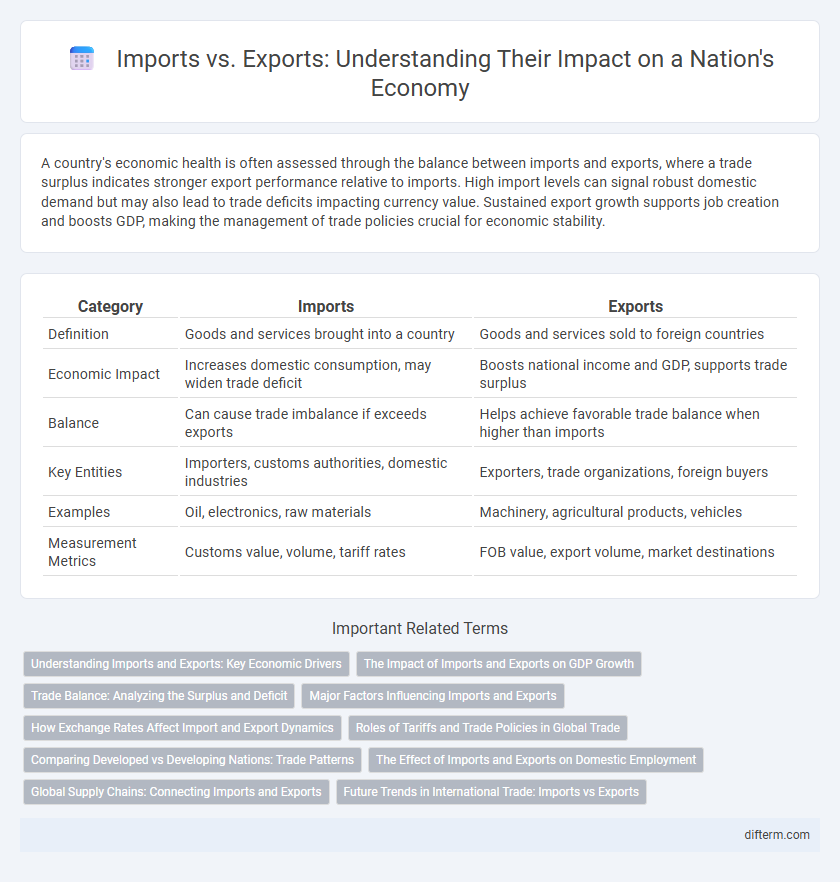A country's economic health is often assessed through the balance between imports and exports, where a trade surplus indicates stronger export performance relative to imports. High import levels can signal robust domestic demand but may also lead to trade deficits impacting currency value. Sustained export growth supports job creation and boosts GDP, making the management of trade policies crucial for economic stability.
Table of Comparison
| Category | Imports | Exports |
|---|---|---|
| Definition | Goods and services brought into a country | Goods and services sold to foreign countries |
| Economic Impact | Increases domestic consumption, may widen trade deficit | Boosts national income and GDP, supports trade surplus |
| Balance | Can cause trade imbalance if exceeds exports | Helps achieve favorable trade balance when higher than imports |
| Key Entities | Importers, customs authorities, domestic industries | Exporters, trade organizations, foreign buyers |
| Examples | Oil, electronics, raw materials | Machinery, agricultural products, vehicles |
| Measurement Metrics | Customs value, volume, tariff rates | FOB value, export volume, market destinations |
Understanding Imports and Exports: Key Economic Drivers
Imports and exports are fundamental components of a nation's trade balance, directly impacting GDP growth and currency valuation. Export growth enhances foreign exchange reserves and supports domestic industries by opening access to global markets, while imports provide critical raw materials, technology, and consumer goods that fuel innovation and consumption. Analyzing trade data and tariff policies reveals the competitive advantages of economies and informs strategic decisions on trade agreements and economic priorities.
The Impact of Imports and Exports on GDP Growth
Exports contribute significantly to GDP growth by increasing production, fostering job creation, and boosting national income through foreign exchange earnings. Imports provide essential inputs and technology that enhance domestic productivity and competitiveness, indirectly stimulating economic expansion. A balanced trade approach helps maintain sustainable GDP growth by optimizing resource allocation and stabilizing market dynamics.
Trade Balance: Analyzing the Surplus and Deficit
A trade surplus occurs when a country's exports exceed its imports, contributing positively to GDP and strengthening the national currency. Conversely, a trade deficit arises when imports surpass exports, potentially leading to increased foreign debt and currency depreciation. Monitoring trade balance trends reveals critical insights into economic health, competitiveness, and policy effectiveness.
Major Factors Influencing Imports and Exports
Trade balance is significantly influenced by exchange rates, with a stronger domestic currency making imports cheaper and exports more expensive, while weaker currency boosts export competitiveness. Domestic production capacity and resource availability determine the volume and type of goods a country imports or exports, shaped by industry specialization and technological advancement. Government policies, including tariffs, quotas, and trade agreements, directly impact import-export dynamics by either restricting or facilitating cross-border trade flows.
How Exchange Rates Affect Import and Export Dynamics
Exchange rates significantly influence import and export dynamics by altering the relative cost of goods between countries. A weaker domestic currency makes exports cheaper and more competitive abroad while increasing the cost of importing foreign goods, potentially reducing import volumes. Conversely, a stronger domestic currency lowers export competitiveness but makes imports more affordable, impacting trade balances and economic growth.
Roles of Tariffs and Trade Policies in Global Trade
Tariffs act as crucial tools in regulating imports and exports, influencing the balance of trade by making imported goods more expensive and encouraging domestic production. Trade policies, including quotas and subsidies, shape global trade dynamics by protecting domestic industries and promoting competitive advantages. These measures directly impact trade flows, foreign exchange rates, and the overall economic growth of countries engaged in international commerce.
Comparing Developed vs Developing Nations: Trade Patterns
Developed nations typically have a more balanced trade profile, with exports often dominated by high-value manufactured goods and technology, while imports include raw materials and consumer products. Developing countries generally exhibit trade patterns characterized by a higher reliance on exporting primary commodities and importing finished goods, reflecting their ongoing industrialization processes. These contrasting patterns affect trade balances, foreign exchange reserves, and economic growth trajectories differently across the two groups.
The Effect of Imports and Exports on Domestic Employment
Exports boost domestic employment by increasing demand for locally produced goods, leading to job creation in manufacturing and service sectors. Imports can create job losses in industries competing with foreign products due to reduced domestic production. However, imports also lower consumer costs and provide raw materials essential for domestic businesses, indirectly supporting employment in other sectors.
Global Supply Chains: Connecting Imports and Exports
Global supply chains play a crucial role in linking imports and exports by enabling the efficient movement of raw materials, components, and finished goods across international borders. The integration of production processes among multiple countries enhances cost-effectiveness and accelerates market access, driving economic growth. Disruptions in supply chains, such as trade restrictions or logistical bottlenecks, significantly impact trade balances and require strategic coordination to maintain global economic stability.
Future Trends in International Trade: Imports vs Exports
Emerging technologies and shifts in global supply chains are expected to redefine future trends in international trade, influencing the balance between imports and exports. Countries with advanced manufacturing capabilities may increase export volumes, while economies focused on consumption could see rising import demands. Data from the World Trade Organization forecasts that digital trade and sustainability standards will drive trade policies, reshaping import-export dynamics.
Imports vs Exports Infographic

 difterm.com
difterm.com